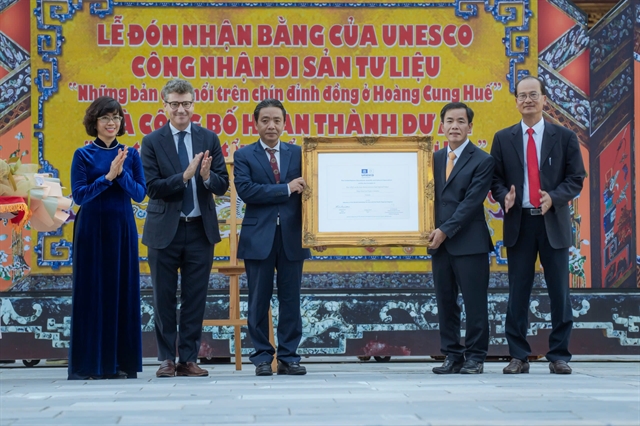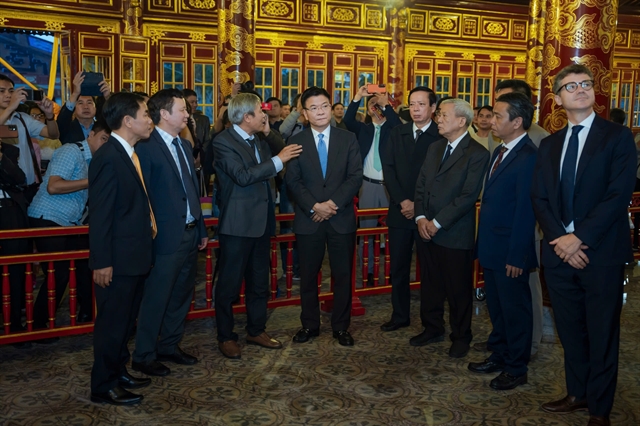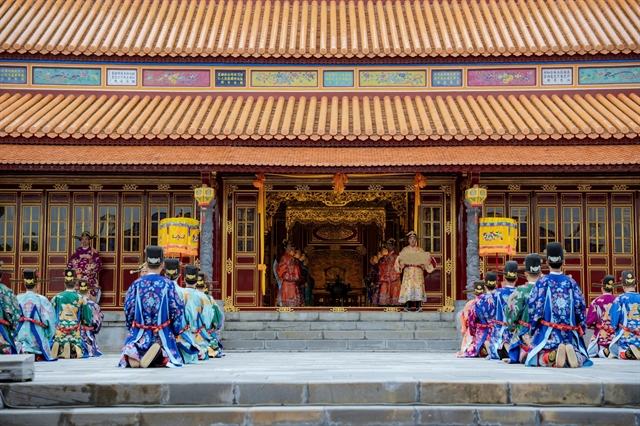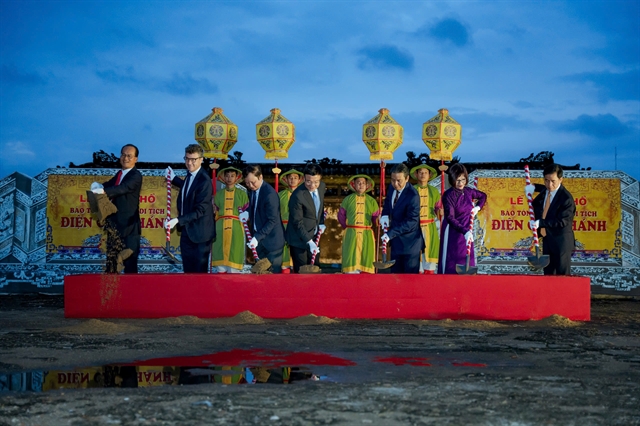Nguyễn Dynasty bronze cast urns receive world heritage recognition
Culture - Ngày đăng : 15:55, 24/11/2024
 |
| Thừa Thiên Huế Province receives the Memory of the World Register recognition for a collection of nine Nguyễn Dynasty urns from UNESCO in a ceremony on November 24. Photo courtesy of Ngọc Hiếu |
THỪA THIÊN-HUẾ — The central province officially received the Memory of the World Register recognition for a collection of nine Nguyễn Dynasty urns from UNESCO in a ceremony on November 24, contributing to the provincial list of eight world heritage certificates.
Deputy Prime Minister Lê Thành Long and ministerial and provincial officials were attendees at the ceremony.
At the same time, the province also inaugurated the restoration of the Thái Hoà Palace (Palace of Supreme Harmony), a UNESCO-recognised world heritage site within the Huế monuments complex – after a three-year upgrade, and began a new renovation project of the Cần Chánh Palace.
 |
| Deputy Prime Minister Lê Thành Long and other officials visit the newly-restored Thái Hoà Palace in the Huế complex in Thừa Thiên Huế Province. Photo courtesy of Ngọc Hiếu |
Chairman of the provincial people’s committee Nguyễn Văn Phương said the UNESCO recognition of the bronze-cast urns showed their huge historical value and the important role during the reign of Emperor Minh Mạng(1802-1945).
“The urn collection, built in 1835-37, was seen as an encyclopedia of Việt Nam in the past centuries. It was recognised as a National Treasure in 2012 by the Prime Minister and now it’s officially listed in the world heritage value and the country’s precious historical and cultural treasure,” Phương said.
“The province also officially reopens the Thái Hoà Palace after a three-year restoration and starts the upgrading and restoration of a new project on the Cần Chánh Palace in improving the world heritage for longer preservation,” he added.
Phương emphasised that the restoration of the world heritage items of the Huế monuments complex has been designed for sustainable development.
He said the province is strongly committed to implementing the preservation and promotion of the world heritage for prosperity and long-term preservation as well as socio-economic development.
Speaking at the ceremony, Representative of UNESCO in Việt Nam Jonathan Baker said it was an honour to celebrate the new inscription of ‘bas-reliefs on the Nine Bronze Urns in Huế Imperial Palace in the Asia Pacific documentary heritage list'.
“The world’s documentary heritage belongs to all of us. It must be fully preserved, protected, and made permanently accessible, with due recognition of cultural practices and practicalities, for all people, without hindrance,” he said.
 |
| A ceremony of the re-opening of the Thái Hoà Palace after a three-year restoration in Thừa Thiên Huế Province. Photo courtesy of Ngọc Hiếu |
“The prestigious recognition has increased Việt Nam’s total registered documentary heritage properties to ten, including three world documentary heritage properties and seven in the Asia-Pacific region,” he added.
He stressed that the urns have preserved the values of intercultural exchanges and interactions between Việt Nam society and other East Asia countries, part of an incredible heritage in Huế.
“UNESCO highly values our enduring partnership with Huế, where conservation of Huế monuments has been carried out with great dedication and has achieved remarkable results. Thirty years ago, UNESCO and global community recognised the urgent need to collaborate with Việt Nam in safeguarding these precious heritage elements.
 |
| A ground-breaking ceremony on the restoration project of the Cần Chánh Palace in the Huế monuments complex. Photo courtesy of Ngọc Hiếu |
He said: ”The challenges we face, as UNESCO and as an important member state of UNESCO such as Việt Nam, involve the preservation, maintenance and physical safeguarding of our world heritage sites. Equally important are contemporary issues that prompt us to engage actively – such as increasing preparedness against the impacts of climate change, making our world heritage sites more resilient to human-induced or natural disasters and optimising the well-being of local populations. This involves greater community engagement, including youth and women, living in and around these heritage sites.”
The nine urn collection, situated in the Thế Miếu (Purple Citadel) yard in the former Huế Imperial City, is one of the most popular destinations for domestic and international tourists.
Each urn represents a king of the Nguyễn Dynasty. All the urns were crafted with the best artisans of the time by the order of Minh Mạng to symbolise the royal power of the ruling dynasty and showcase the kingdom of Đại Nam's beautiful flora and fauna.
The urns, cast over two years, were created with the aspiration of building a strong and stable country for future generations. VNS
